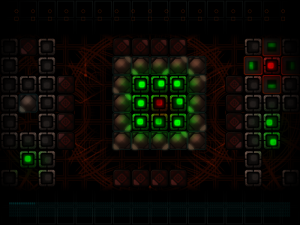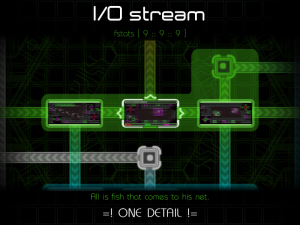Official Site || Steam Page (Commercial Version) || Game Jolt Page
Block-pushing puzzles may very well be the most common types of puzzles in the entire video game industry and games built entirely around this concept are also quite common, so the degree of innovation and unique style found in Sig.NULL is a rather pleasant surprise. Though the basic goal of pushing blocks onto designated areas to complete a level still serves as the backbone to Sig.NULL’s gameplay, the actual way in which this is accomplished and the tools at your disposal are far from normal. These unusual twists to familiar concepts are accomplished in large part due to Sig.NULL taking full advantage of its setting, the inside of a malfunctioning computer.
The most crucial thing to understand about this game is the fact that there is not a visible, controllable protagonist and, instead, you take on the role of an unseen admin controlling ‘socket’ drones’ to move blocks onto the appropriate socket symbols on the ground, presumably in order to resolve various programming conflicts. This may not sound like much of a difference from controlling a character, but it definitely is and Sig.NULL does its best to rapidly teach you the importance of this difference. As there is no direct protagonist, there is no limitation on the number of drones present in any given level and this is where things get tricky.
 If I had to tie a theme to this game, it would probably be ‘degrees of control’. You have full control over every drone in a stage at all times, whether you want to or not. What this means is Sig.NULL is a game which is more than happy to frequently give you control over somewhere around half a dozen drones which all simultaneously move at the push of a button, often resulting in a chaotic nightmare of blocked passages and blocks getting pushed in the wrong areas unless you monitor every single move you make. Except, you still only ever actually control one drone at a time, but it might be a drone tucked away in the corner, surrounded by colored switches facing in various directions and colliding with these switches is what actually controls the swarm.
If I had to tie a theme to this game, it would probably be ‘degrees of control’. You have full control over every drone in a stage at all times, whether you want to or not. What this means is Sig.NULL is a game which is more than happy to frequently give you control over somewhere around half a dozen drones which all simultaneously move at the push of a button, often resulting in a chaotic nightmare of blocked passages and blocks getting pushed in the wrong areas unless you monitor every single move you make. Except, you still only ever actually control one drone at a time, but it might be a drone tucked away in the corner, surrounded by colored switches facing in various directions and colliding with these switches is what actually controls the swarm.
These switches are not just for show as their indirect nature is played with frequently. For example, you might have control over a red drone which, when moved left, touches an upward-facing pink switch which may in turn make a pink drone move up and touch a left-facing green switch to make every green drone move left. At other times, the switches for a single drone color may be divided between two drones of the same color or there may just simply not be a switch present to move a certain drone in a certain direction or it may even be that you must manipulate the switches for two different types of drones simultaneously. Deciphering the actual limits of what you can and cannot do in each stage often is just as important, and just as much of a puzzle, as figuring out which moves to make.
 I’ve been mentioning drone colors a lot and these colors are another important element as socket drones of each color have their own trait to be aware of. These traits range anywhere from potentially useful, such as red drones swapping positions with any inactive grey drones they touch, to actively harmful, such as light blue drones leaving behind impenetrable walls. In most cases the ability of a drone can be either positive or negative depending on the stage itself, such as with ‘corrupt’ orange drones which turn grey drones into more orange drones on contact and ‘unstable’ yellow drones which can be made to explode and take out walls (and anything else) adjacent to them. There’s even a drone which isn’t affected by the otherwise extremely useful rewind function, the existence of which is responsible for some of the most devious puzzles in the game.
I’ve been mentioning drone colors a lot and these colors are another important element as socket drones of each color have their own trait to be aware of. These traits range anywhere from potentially useful, such as red drones swapping positions with any inactive grey drones they touch, to actively harmful, such as light blue drones leaving behind impenetrable walls. In most cases the ability of a drone can be either positive or negative depending on the stage itself, such as with ‘corrupt’ orange drones which turn grey drones into more orange drones on contact and ‘unstable’ yellow drones which can be made to explode and take out walls (and anything else) adjacent to them. There’s even a drone which isn’t affected by the otherwise extremely useful rewind function, the existence of which is responsible for some of the most devious puzzles in the game.
It’s unusual to have the variety in a block-pushing game come from the ‘characters’ rather than the blocks themselves, and there is indeed only one type of block, but that doesn’t mean it isn’t special. Every pushable block starts with one of its four corners lit up and every socket location on the floor likewise has a highlighted corner. This isn’t just a matter of matching specific blocks to specific sockets though as pressing the spacebar when a socket drone is next to a block will rotate which corner is lit up (this also means the lit corner rotates simultaneously for every single block next to any given drone). Furthermore, blocks with matching lit corners become linked and moving one will move the other. Add in purple tiles which only blocks can enter and the importance of creating ‘loops’ by linking and unlinking sets of blocks as needed quickly becomes one of the most crucial skills to master.

Sig.NULL’s aesthetics are fantastic and fit the setting well, but they sometimes get in the way. On the plus side of things the sound design goes a long way towards setting the tone and creating an oddly oppressive and somewhat mysterious atmosphere with many of the songs and sound effects containing an element of muted malevolence. The visuals are simple, but sleek and effective when it comes to teaching the player about new mechanics without any written tutorials. Even the level names play into establishing the setting as they will consist of a handful of letters until you ‘fix’ the level to see the full name. On the other side of things, the blocks and sockets sometimes blend in with their surroundings so well that it can become easy to miss one tucked away into a corner somewhere; there is an indicator at the top showing the number of blocks and sockets in the level, which is particularly important for stages where yellow drones must be used to uncover hidden sockets or to destroy excess blocks, but it is integrated into the background to such a degree that I did not even realize it existed until several hours in. Zooming around on the twisting currents of data which connects levels serves as a great visual effect and not always being able to see where a path will lead upon completing a level aids in creating a sense of exploration, but it can also lead to a decent amount of frustration when traveling between regions as you try to remember which path leads where.
Minor frustrations aside, Sig.NULL is a deeply atmospheric and highly-challenging puzzle game with hours upon hours of content and unique mechanics which it pushes to their limits.